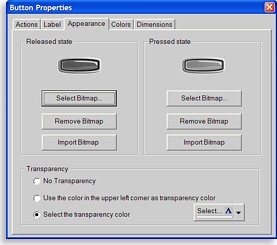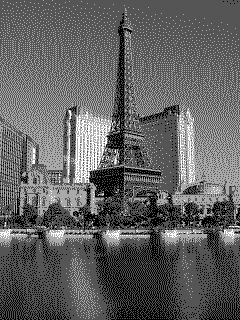|
...Continued from Page 14.

The Button Properties screen. |
Assembling the elements.
Buttons and panels can be any size from 1 by 1 pixel up to the full area of the screen. An object’s dimensions are determined by the size of the assigned bitmaps (although in the case of plain objects without bitmaps it’s possible to enter an exact dimension manually). If no pressed image exists, the remote will automatically reverse the regular bitmap during normal use. Buttons have four possible color settings: background and text, for both pressed and released states. The background color setting is ignored if bitmaps have been attached.
Custom bitmaps must be stored in the Windows BMP format and, although ProntoEdit NG can work with full color images, for best results images should be pre-converted to the TSU3000’s default 16 greyshades in a true bitmap editing program such as Adobe Photoshop or Corel PHOTO-PAINT. If PENG is allowed to make the conversion, the end result is often less than perfect.
For more information on how to make your images look their best, check out my article Tips for Creating Quality ProntoPro Graphics, which describes several rendering concepts. Although originally written for the ProntoPro, these tips will also work with the TSU3000 (except, of course, the one on choosing colors).
 
A comparison of the TSU2000's 4 shades (left) and the TSU3000's 16 shades (right). |
I can see through you!
New to the Pronto family is support for image transparencies. Each object with assigned bitmaps can have a color deemed transparent – meaning that anything in the bitmap of that color will become invisible, allowing whatever is behind the object to show through. This is an extremely useful and timesaving feature that has been requested for a long time.
However, the implementation is hampered by the requirement of picking a transparent color from one of the 16 normal greyshades, rather than some completely unrelated color such as red or blue. Most quality rendered buttons already make use of all 16 shades, making it problematical to find a color that could be sacrificed. In addition, all sections of that color will become transparent, even if they’re in the middle of the image. On the upside, the TSU3000 makes only a button’s visible portion clickable. So, if you have a round button saved as a customary square file and then set the outer corners transparent, only the center round portion will do anything when pressed.
High resolution computer monitor? Think you’ll find it hard to see ProntoEdit NG’s tiny editing pages? Relax, there’s a zooming function that can magnify pages by 200, 300 or even 400 percent (or reduce it by 50 percent if you’re feeling macho).

Adding commands to a macro. |
The Five Commandments
Double-clicking on a new button opens the Device Properties’ “Actions” tab, where all operational commands are placed. The two radio buttons on the left select between “Normal Actions” (such as multiple learned and preprogrammed codes) and a “Special Action” (such as activating the backlight, browsing to a previously viewed page, switching to the next device, jumping to the home page or accessing the Setup menu). It’s impossible to combine a special action with normal commands, or to stack multiple special actions on the same button (such as going back three pages). However, the remote does support a nearly unlimited number of normal actions on each button – better known as macros.
Along the right side of the screen are five new command types: “Add IR Code”, “Create Link”, “Add Delay”, “Add Beep” and “Create Jump”. Each of these adds a single line, or macro step, to the “Normal Actions” window on the left. The order of commands can be changed at any time via two arrow buttons. On the Pronto NG, normal buttons with just one function are still technically macros – just very short ones!
| 
